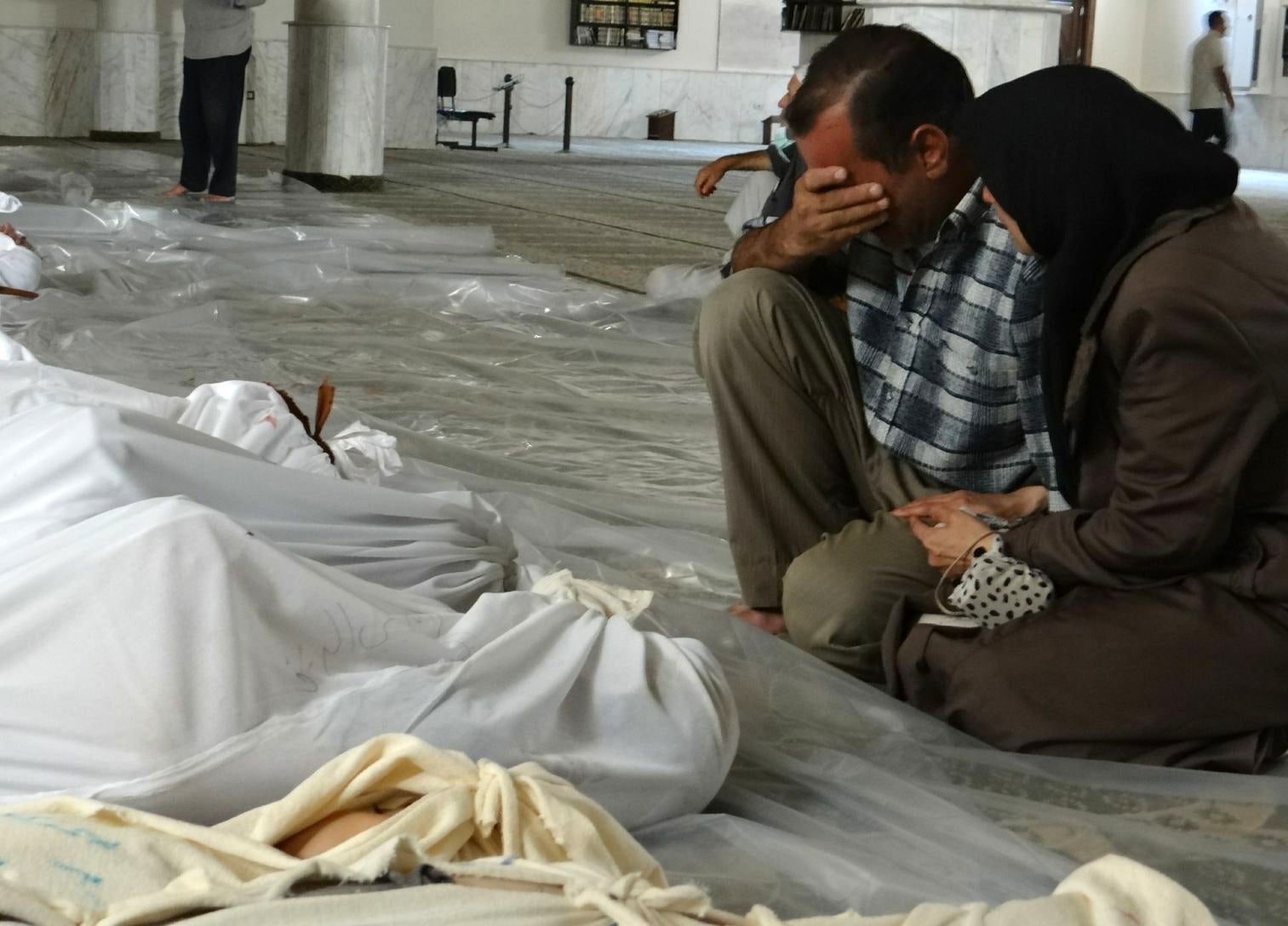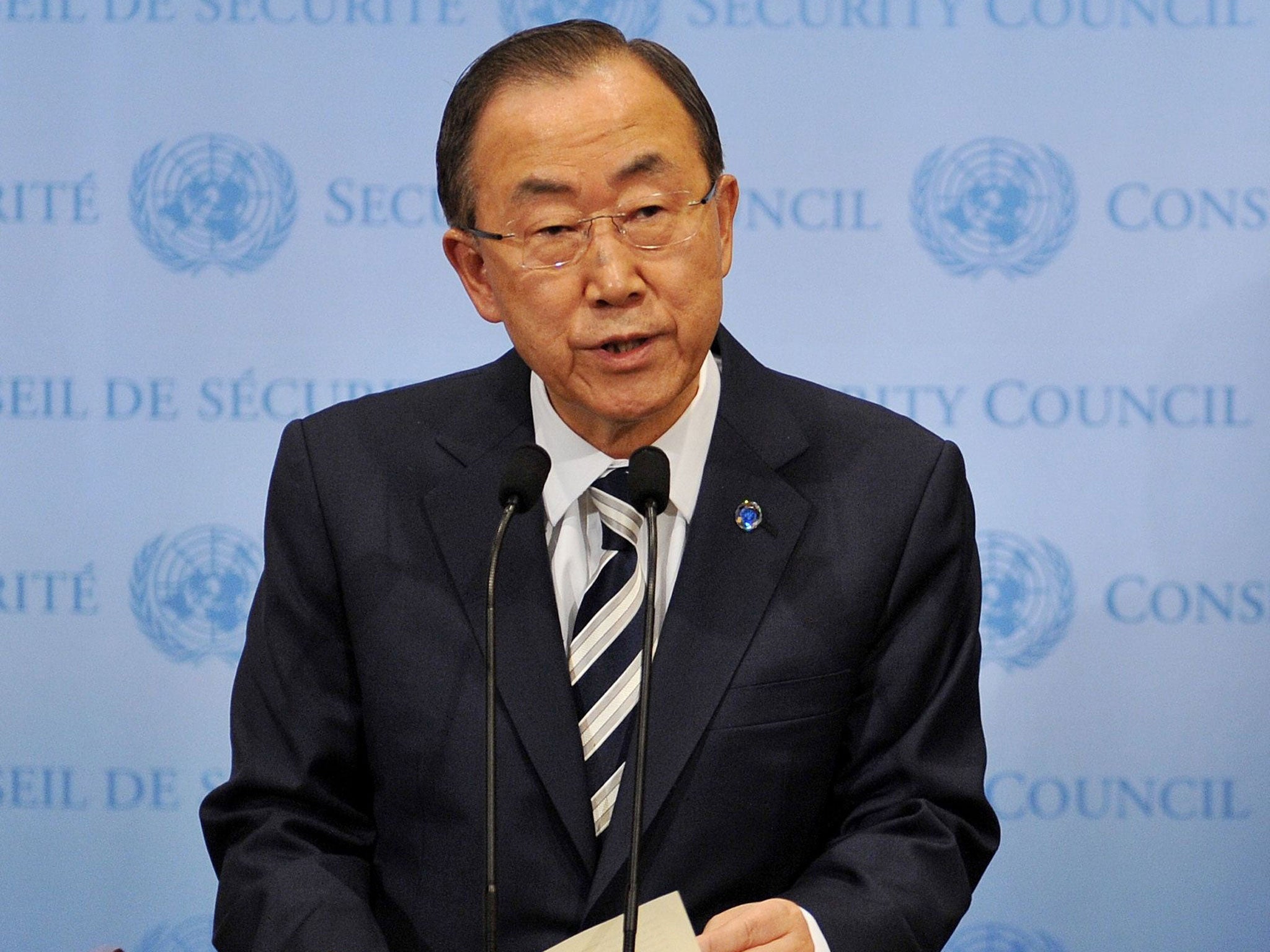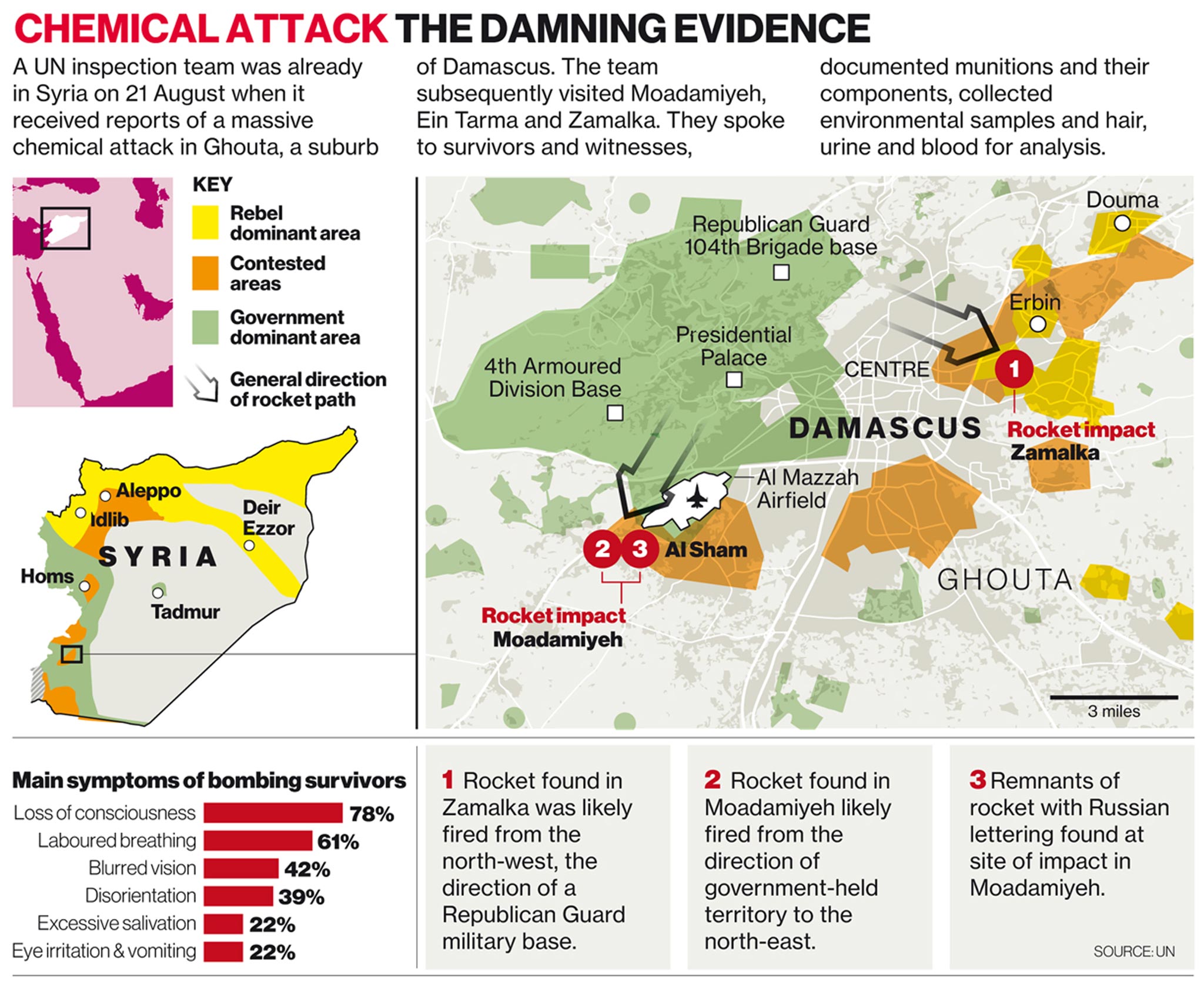Syria gas attacks: the clear and concise evidence from UN chemical weapons inspectors
UN concludes sarin gas used in conditions ‘designed to cause maximum suffering’

A grim United Nations inspectors’ report offered “clear and convincing evidence” on Monday that poison gas was used “on a relatively large scale” in the Ghouta suburbs of Damascus on 21 August when weather conditions – cold, falling air – ensured it would cause maximum death and suffering, seeping silently into basements and underground shelters.
While the document, submitted formally to the Security Council by the Secretary General, Ban Ki-Moon, does not explicitly assign responsibility for the attacks, it clearly suggests that in at least two instances rockets designed to release sarin gas were fired from the direction of territory held by government forces. One of those appeared to have come from the direction of a large Syrian army base.
The report “confirms the position of those of us who have said that the regime is guilty”, French Foreign Minister Laurent Fabius said yesterday. “When you look at the facts, the quantities of toxic gas used, the complexity of the mixing, the nature and trajectory of the vectors, all that leaves absolutely no doubt as to the origin of the attack.”
The US envoy to the UN, Samantha Power, noted that the regime has sarin gas and there is “no evidence” the rebels do. “The UN report confirms unmistakably that chemical weapons were used,” she told reporters in New York. “The mandate of the chemical weapons team was, as you well know, not to investigate culpability. But the technical detail of the UN report makes clear that only the regime could have carried out this large-scale chemical weapons attack.”
“This was no cottage-industry use of chemical weapons,” said Sir Mark Lyall, the British ambassador.

First reports from residents and non-governmental groups of chemical weapons use set in train the crisis that saw the United States threaten military action and the negotiation at the weekend of the Russian-US pact to confiscate and destroy the weapons.
But yesterday was the first time in a quarter of a century that the United Nations formally declared the deliberate deployment of prohibited chemical weapons against soldiers or civilians.
President Bashar al-Assad, who agreed last week to sign the Chemical Weapons Convention, has applied to the US for a visa to attend next week’s UN General Assembly in New York. The State Department declined to comment.
The UN team, which came under sniper fire the first time it attempted to visit the affected areas five days after the attacks, based their findings on an array of evidence, including soil samples, examination of munitions fragments, analysis of blood, urine and hair from victims as well as extensive interviews with more than fifty exposed survivors including doctors and nurses who rushed to the scene.
“On the basis of the evidence obtained during the investigation of the Ghouta incident, the conclusion is that chemical weapons have been used in the ongoing conflict between the parties in the Syrian Arab Republic, also against civilians, including children, on a relatively large scale,” said the report, compiled by chief UN investigator who lead the team, Ake Sellstrom of Sweden.
It also confirmed that that assault involved rockets fitted to release quantities of Sarin gas. Of 34 blood samples analysed, 91 per cent were positive for sarin exposure. “The environmental, chemical and medical samples we have collected provide clear and convincing evidence that surface-to-surface rockets containing the nerve agent sarin were used,” the report said.
The inspectors found parts of rockets and damage to buildings in the Moadimayah district of West Ghouta and the Zamalka and Ein Tarma neighbourhoods of East Ghouta, suburban areas that were largely under rebel control. By citing the weather conditions, the report implies careful forward planning; temperatures were falling between 2am and 5am. “This means that air is not moving from the ground upwards, but rather the opposite. Chemical weapons use in such meteorological conditions maximises their potential impact as the heavy gas can stay close to the ground and penetrate lower levels of buildings where many people were seeking shelter.”
Some of the witness testimony was taken from health care workers and first responders, many of whom lived in nearby neighbourhoods and rushed to help the victims. Nine nurses and seven doctors were interviewed and several of them suffered symptoms of having been exposed to sarin, “with one describing the onset of blurred vision, generalised weakness, shaking, a sensation of impending doom, followed by fainting.”
When the first responders reached the areas hit by the rockets they saw “a large number of individuals lying on the ground, many of whom were deceased or unconscious.
The report acknowledges that determining trajectories was only possible in two of the five rocket impact areas. “Impact site number one (Moadamiyah) and impact site number four (Ein Tarma) provide sufficient evidence to determine, with a sufficient degree of accuracy, the likely trajectory of the projectiles,” it said in an annex, which also offered pictures of the rockets as well as identifying markets in Russian lettering.
The regime and its allies, notably Russia, have claimed the atrocity was carried out by the rebels to ‘frame’ President Assad. In that narrative one could say the opposition had deliberately used Russian made rockets. It would, however, be hard to explain how they managed to carry out the operation from several points inside regime territory. Mr Sellstrom moreover told envoys the sarin gas was of high purity and concentration.
Included in the report was confirmation that because so many of the victims were sleeping when the rockets came in, it often happened that single families lost multiple members. In Zamalka, two brothers who were interviewed said that of the 40 members of their family who were all living in the same building only they had survived.
Under fire: How Ghouta was targeted
* By studying the site of impact, the team determined that the rockets were fired from several locations – both of which were in territory held by government forces.
* The type of munitions used in the attack – the M14 artillery rocket – has not been seen in the possession of the rebels at any point during the conflict.
* The rockets were fired from a number of locations suggests a coordinated attack.
* Exploded surface-to-surface rockets capable of carrying a chemical payload were found to contain sarin.
* The ground surrounding the rocket impact sites was found to be contaminated with sarin.
* Blood and urine samples from survivors tested positive for sarin.

Join our commenting forum
Join thought-provoking conversations, follow other Independent readers and see their replies
Comments
Bookmark popover
Removed from bookmarks